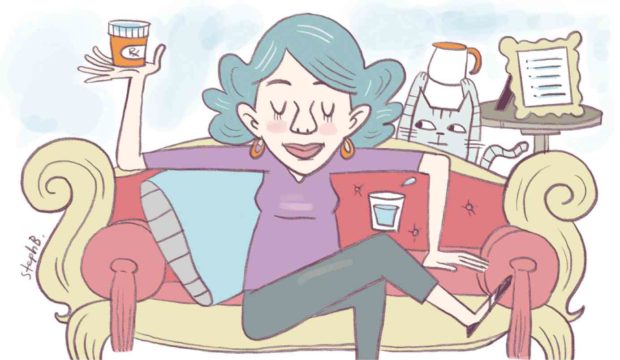
A few weeks ago, we had to admit an elderly diabetic patient whose heart suddenly developed an irregular heartbeat, with a rate of 140-160 beats per minute.
She had cold, clammy perspiration. The rhythm was atrial fibrillation. But in her check-up just a month earlier, it was a regular, normal rhythm.
When her blood sugar was checked in the emergency room, it was 60 mgs/dl, a low level called hypoglycemia. This made her heart irritable and triggered the arrhythmia.
Fortunately for her, with the correction of the low blood sugar (we made her drink a glass of sweetened orange juice) and intravenous fluids, plus another intravenous medication to stabilize her irregular heartbeat, her heart rhythm reverted to normal after a few hours.
Diabetic patients really have to walk a tightrope trying to control their blood sugar levels. Too high or too low levels can lead to potentially serious complications.
Diabetes specialists sometimes differ in opinion, but I believe that the hearts of diabetics can tolerate better a slightly elevated blood sugar level than a low level—like the patient whose case we cited.
So, in diabetics with really bad hearts, particularly among the elderly, we coordinate with the specialist managing their diabetes, and agree on less stringent blood sugar control.
Normal level
The normal HbA1c level is around 6 percent, and for most diabetics, the target HbA1c is 6.5 to 7 percent. But among the elderly, especially those with a bad heart, who are bedridden, and have other medical problems with expected limited life span, a higher HbA1c level of 8 to 8.5 percent may be safer to prevent severe hypoglycemia.
Speaking of safety, an article on how to keep the home safe and healthy for diabetics is published in the December issue of Diabetease magazine.
Written by Dr. Jocelyn Capuli-Isidro, a noted endocrinologist (diabetes specialist), it offers some practical pointers to make sure the home is conducive to help keep a diabetic loved one in good health, and prevent complications like hyperglycemia (high blood sugar levels) and hypoglycemia.
“Safety at home doesn’t just include the smoke alarms for fire and carbon monoxide but also precautions in cases of diabetes emergencies and… complications,” writes Dr. Isidro.
She has coined the acronym SAFETY for these pointers:
Sleep well: Some studies show that poor sleep may lead to poor blood sugar control, says Dr. Isidro. “And, not only does having adequate sleep time matter, but so does having good sleep quality in improving sugar control.” Therefore, the bedroom should be made conducive to good sleep.
Access to important information: The patient’s caretakers or relatives should be aware of medications. A small cork board near the kitchen cabinets can have the list of patient’s doctors, and the name of the hospital where the patient consults. A small sticky note can also be placed on the fridge to indicate where medical records are kept.
Dr. Isidro adds:
“Patients can also have medical-alert bracelets that indicate their names and illnesses. Medications should be kept separate from the rest of the common household medical remedies. These medications must be placed in separate pillboxes. Initials may be written on the tops of pillboxes with permanent marker for faster identification.”
Feet first: Floors should always be kept clean and tidy for patients with diabetic neuropathy who have lost protective sensation in their feet, Dr. Isidro says.
Enjoyable abode: Dr. Isidro stresses the importance of harmony in the home. She says: “Diabetes in the family entails full support from family members. Eating healthy is not just for those with diabetes, but also for everyone. It is advisable that the same healthy food be served at the dinner table for everyone, so that the person with diabetes doesn’t feel left out.”
Unity is also shown in carrying out regular physical activities. Dr. Isidro says that scheduled family exercise early in the morning is a strong motivation for the patient to keep fit.
“However, it is very important to check blood glucose before and after every activity,” she points out. “A readily available carbohydrate-containing snack should always be within reach. In anticipation of a physical activity, dose adjustment of insulin at the meal before exercise is advised.”
Test sugars: Diabetes specialists recommend monitoring blood sugar levels at different times—before breakfast, at random or two hours after meals. This ensures blood sugar control at all times. This can also identify the times of sugar fluctuation. Blood sugar measuring gadgets called CGM (continuous glucose monitor) are very useful especially for diabetics who are on insulin pumps, to prevent hypoglycemia and control hyperglycemia.
Yucky lows: Developing hypoglycemia is a major concern for diabetics on antidiabetic pills like sulfonylureas and those on insulin. Some patients may develop signs and symptoms such as cold, clammy perspiration, tremors, weakness and dizziness and rapid heartbeat, but many patients do not feel these warning signs when their blood sugar levels are low. “If left undetected, it can lead to drowsiness or coma,” Dr. Isidro warns.
There must be readily available sources of sugar at home to combat hypoglycemia, such as glucose tablets and sweetened juices. “But remember, these should only be given in times of emergency. More importantly, people living with a diabetes patient should be able to identify these rapid-acting sources of sugars and administer them right away when the need arises.”